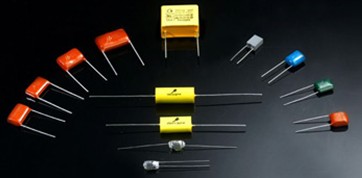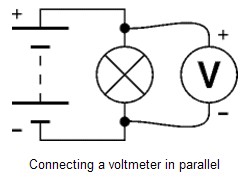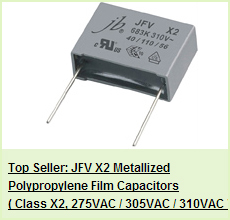2010-12-8 1:10:32
views
Aluminum electrolytic capacitors are made by layering the electrolytic paper between the anode and cathode foils, and then coiling the result. The process of preparing an electrode facing the etched anode foil surface is extremely difficult. Therefore, the opposing electrode is created by filling the structure with an electrolyte. Due to this process, the electrolyte essentially functions as the cathode.
Electrolytic capacitors are soaked in a liquid or paper impregnated with a liquid which is not a dielectric but when a voltage is applied creates a layer of aluminium oxide which acts the dielectric. The reaction is dependent on the polarity of the applied voltage. If the polarity is reversed the capacitor will produce a gas and is likely to explode or burst because of the pressure inside and so are not suitable for alternating current applications.
2010-12-7 1:5:59
views
A capacitor is an electronic device for storing charge. Capacitors can be found in almost any complex electronic device. They are second only to resistors in their There are many different types of capacitor but they all work in essentially the same way. A simplified view of a capacitor is a pair of metal plates separated by a gap in which there is an insulating material known as the dielectric. This simplified capacitor is also chosen as the electronic circuit symbol for a capacitor is a pair of parallel plates as shown  .
.
jb Various types of capacitor

2010-12-6 4:20:12
views
Symbol:T
Unit:(s)
When a capacitor discharges its charge throught a resistor, the charge of the capacitor decreases with time. The decreasing charge follows an exponential decay curve.
http://www.jbcapacitors.com/
2010-12-6 1:0:27
views
A super capacitor is also known as a double-layer capacitor. It polarizes an electrolytic solution to store energy electro statically. Though it is an electrochemical device, no chemical reactions are involved in its energy storage mechanism. This mechanism is highly reversible, and allows the ultra capacitor to be charged and discharged hundreds of thousands of times.
A super capacitor can be viewed as two non reactive porous plates, or collectors, suspended within an electrolyte, with a voltage potential applied across the collectors. In an individual super capacitor cell, the applied potential on the positive electrode attracts the negative ions in the electrolyte, while the potential on the negative electrode attracts the positive ions. A dielectric separator between the two electrodes prevents the charge from moving between the two electrodes.
2010-12-3 4:18:42
views
A super capacitor is also known as a double-layer capacitor. It polarizes an electrolytic solution to store energy electro statically. Though it is an electrochemical device, no chemical reactions are involved in its energy storage mechanism. This mechanism is highly reversible, and allows the ultra capacitor to be charged and discharged hundreds of thousands of times.
A super capacitor can be viewed as two non reactive porous plates, or collectors, suspended within an electrolyte, with a voltage potential applied across the collectors. In an individual supercapacitor cell, the applied potential on the positive electrode attracts the negative ions in the electrolyte, while the potential on the negative electrode attracts the positive ions. A dielectric separator between the two electrodes prevents the charge from moving between the two electrodes.
2010-11-30 4:5:9
views

◆Voltage is a measure of the energy carried by the charge. Strictly: voltage is the "energy per unit charge".
◆The proper name for voltage is potential difference or p.d. for short, but this term is rarely used in electronics.
◆Voltage is supplied by the battery (or power supply).
◆Voltage is used up in components, but not in wires.
◆We say voltage across a component.
◆Voltage is measured in volts, V.
◆Voltage is measured with a voltmeter, connected in parallel.
◆The symbol V is used for voltage in equations.
2010-11-27 12:29:36
views
2010-11-26 15:17:36
views
It might seem a good idea to make the farad (F) much smaller to avoid having to use µF, nF and pF, but if we did this most of the equations in electronics would have to have factors of 1000000 or more included as well as the quantities. Overall it is much better to have the units with their present sizes which are defined logically from the equations.
In fact if you use an equation frequently you can use special sets of prefixed units which are more convenient...
For example: Ohm's Law, V = I × R
the standard units are volt (V), amp (A) and ohm (Ω),
but you could use volt (V), milliamp (mA) and kilo-ohm (kΩ) if you prefer.
Take care though, you must never mix sets of units: using V, A and kΩ in Ohm's Law would give you wrong values.

















